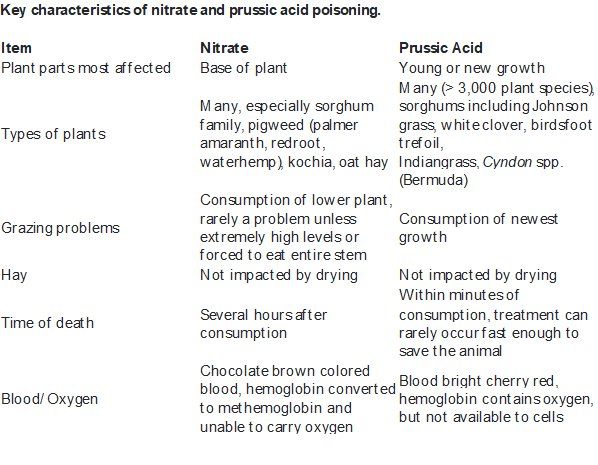Many cattle operations rely on some type of harvested feed to use in the winter months and common among those sources is forage sorghum, millets, sorghum-sudangrass, and sudan. Forages in the sorghum family are prone to two different problems for feeding cattle, nitrate poisoning and prussic acid (hydrocyanic acid, HCN) poisoning. Millet (proso and pearl) do not contain prussic acid but can have nitrates. Prussic acid and nitrate poisoning are easy to get confused because both result in a lack of oxygen availability to the animal and are more likely to occur when the plant is stressed (fertility, hail, drought).
In dry areas of the state, cattle may be removed from pasture early. Bringing hungry cattle into pens with weeds can be very dangerous as the nitrate concentration may be elevated throughout the plant and animal intake high. Manure in corrals can contribute to the elevation of nitrates in the weeds. Elevated nitrates may not result in death but could cause abortions.
The current KSU forage fact sheet on prussic acid poisoning indicates that prussic acid potential dissipates as the forage dries. Additionally, hay or silage that likely contained high cyanide concentrations at harvest should be analyzed before it is fed. This second statement is often forgotten and it’s assumed that when the plant dries, all the cells are ruptured and any HCN is released. To confirm this, we measured dhurrin content in sorghum hay in a study last year. The dhurrin content was stable from 1 to 10 weeks of dry storage. In the plant, dhurrin (the precursor to HCN in sorghum species) and the enzyme that converts it to cyanide, are stored in separate compartments within the cell. When the plant is eaten, the compartments are ruptured, and the cyanide formed and released. Measurement of dhurrin directly is used in some research studies. However, commercial labs do not typically measure dhurrin directly. Rather, the procedure includes something to stimulate cyanide release. If hay is made from forages in the sorghum family or other susceptible species, testing for prussic acid in forage that has suffered from drought, hail or fertility issues is advised. Testing is cheap compared to the cost of losing even one animal.


Alicia Boor is the Agriculture and Natural Resources agent with K-State Research and Extension – Cottonwood District. Contact her by email at aboor@ksu.edu or call 620-793-1910.





